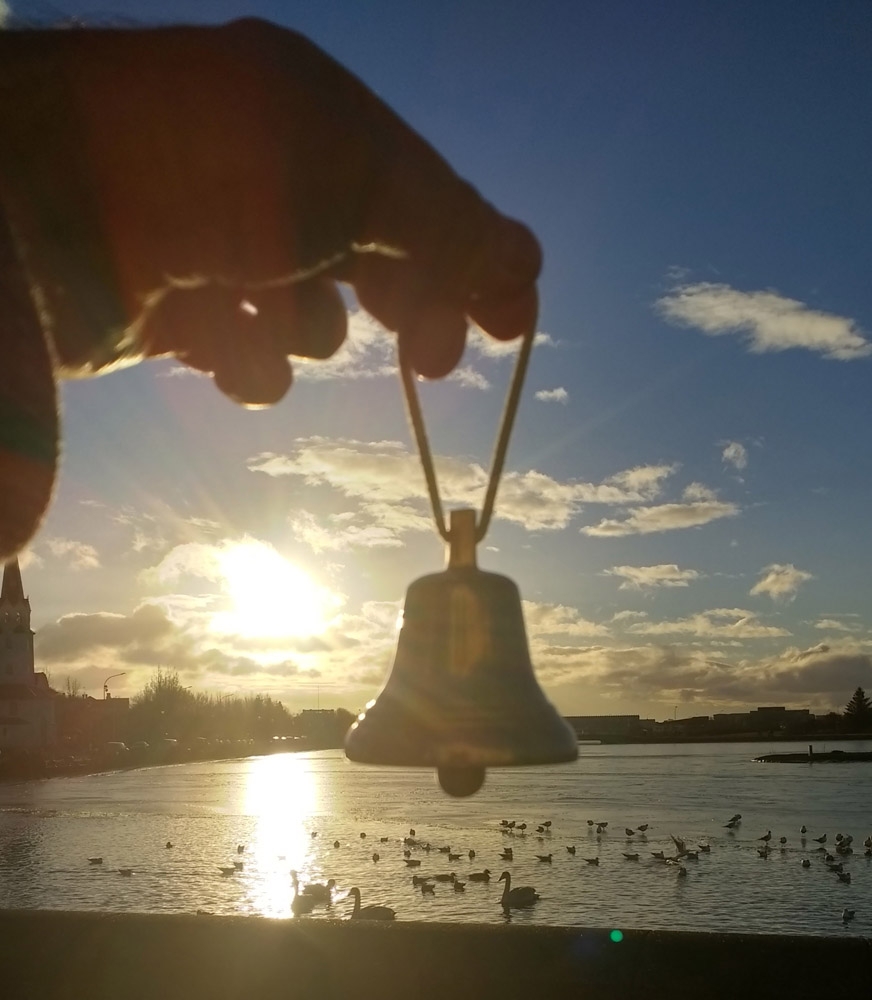One thing to say about David Horvitz’s participatory performance work Let Us Keep Our Own Noon (2013) is that it proves a lesson in the safety of the pack. Forty-seven bells, all smelted from the material of a single French church bell, are strung up on a wire line stretched across the foyer of the National Gallery of Iceland in Reykjavik. At just gone noon the artist invites members of the public to each take one bell each and go out into the street. We can go wherever we please, ringing the bell, but must continue until we can no longer hear anyone else’s chimes. At first, as I ring my bell in the Reykjavik cold, I feel a sense of excitable communality. People turn to stare, but, while we are amassed together, it is obvious we’re taking part in a performance of some kind, which buoys our confidence. As I walk further from the gallery however, slowly loosing my bell-ringing comrades, I become more self-conscious. At the point that the only chime I can hear is my own, I realise I might look a trifle odd.
I realise I might look a trifle odd
The performance marks the tenth anniversary of Sequences, the Icelandic capital’s biennial festival of ‘real time art’ (so, mostly performance and video, but, in previous years at least, happily stretching into sculpture and painting). Previously over a Skype link from New York, the curator of the 2017 edition, New Museum associate curator Margot Norton, had announced Joan Jonas as the honorary artist around whose work her festival will obit.
Ringing the bells collectively felt celebratory; on my own, the lonesome tinkling felt mournful. Horvitz had spoken about the walk and the bell as an alternative mode of measuring time (we were encouraged to leave our phones and watches at the gallery) and it wasn’t long before I had the maudlin idea that ending up on my own was somewhat analogous to the progress of life.
This was supposed to be a birthday party though: from the National Gallery the crowd moved on to the artist-run gallery Mengi where a vast meringue cake was served (onto which Hildigunnur Birgisdóttir projected a series of .gif animations), and a rambunctious sculpture-making competition got under way. Compered by artist Kolbeinn Hugi Höskuldsson with a soundtrack by artist Ragnar Kjartansson (under the guise of DJ Emotional) 12 teams of two each had 15 minutes to make a sculpture out of a heaped pile of assorted packaging, bits of old textiles, offcuts of wood, plastic and other debris. The eventual winner was lost to me in the chaos and enthusiastic commentary in Icelandic (a language which eludes me).
As dusk fell, down at Reykjavik’s harbour, we listened to the dawn arriving
As dusk fell, down at Reykjavik’s harbour, we listened to the dawn arriving. This was Daybreak, Forever (2016), Ragnar Helgi Ólafsson’s sound installation in a storage cupboard: a live broadcast relaying the environmental sound from the moment of sunrise at various locations around the world. Bird song in Hawaii, the sounds of rush hour traffic in New York. A public toilet next door served as an odd reception venue (and sanctuary from the wind) for the vernissage. Standing among the urinals, drinking beer with the city’s artists and curators, it struck me that today’s activities offered a perfect postcard of the Icelandic art scene: one part romantic, one part surreal, one part beauty, one part party.
David Horvitz’s Let Us Keep Our Own Noon will be on view at the National Gallery of Reykjavik through 21 December; Ragnar Helgi Ólafsson’s Daybreak, Forever can be heard until Sequences VIII which takes place 6–15 October 2017
Online exclusive published 23 November 2016
